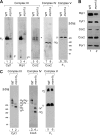Mzm1 influences a labile pool of mitochondrial zinc important for respiratory function
- PMID: 20404342
- PMCID: PMC2885224
- DOI: 10.1074/jbc.M110.109793
Mzm1 influences a labile pool of mitochondrial zinc important for respiratory function
Abstract
Zinc is essential for function of mitochondria as a cofactor for several matrix zinc metalloproteins. We demonstrate that a labile cationic zinc component of low molecular mass exists in the yeast mitochondrial matrix. This zinc pool is homeostatically regulated in response to the cellular zinc status. This pool of zinc is functionally important because matrix targeting of a cytosolic zinc-binding protein reduces the level of labile zinc and interferes with mitochondrial respiratory function. We identified a series of proteins that modulate the matrix zinc pool, one of which is a novel conserved mitochondrial protein designated Mzm1. Mutant mzm1Delta cells have reduced total and labile mitochondrial zinc, and these cells are hypersensitive to perturbations of the labile pool. In addition, mzm1Delta cells have a destabilized cytochrome c reductase (Complex III) without any effects on Complexes IV or V. Thus, we have established that a link exists between Complex III integrity and the labile mitochondrial zinc pool.
Figures








Similar articles
-
Unique, Diverged, and Conserved Mitochondrial Functions Influencing Candida albicans Respiration.mBio. 2019 Jun 25;10(3):e00300-19. doi: 10.1128/mBio.00300-19. mBio. 2019. PMID: 31239372 Free PMC article.
-
A structural model of the cytochrome C reductase/oxidase supercomplex from yeast mitochondria.J Biol Chem. 2007 Apr 20;282(16):12240-8. doi: 10.1074/jbc.M610545200. Epub 2007 Feb 23. J Biol Chem. 2007. PMID: 17322303
-
Mitochondrial assembly in respiration-deficient mutants of Saccharomyces cerevisiae. I. Effect of nuclear mutations on mitochondrial protein synthesis.J Biol Chem. 1973 Aug 10;248(15):5360-8. J Biol Chem. 1973. PMID: 4358612 No abstract available.
-
Function of the iron-sulfur protein of the cytochrome b-c1 segment in electron-transfer and energy-conserving reactions of the mitochondrial respiratory chain.Biochim Biophys Acta. 1981 Dec 4;639(2):129-55. doi: 10.1016/0304-4173(81)90008-2. Biochim Biophys Acta. 1981. PMID: 6272847 Review. No abstract available.
-
Revealing various coupling of electron transfer and proton pumping in mitochondrial respiratory chain.Curr Opin Struct Biol. 2013 Aug;23(4):526-38. doi: 10.1016/j.sbi.2013.06.013. Epub 2013 Jul 16. Curr Opin Struct Biol. 2013. PMID: 23867107 Review.
Cited by
-
Protein-mediated assembly of succinate dehydrogenase and its cofactors.Crit Rev Biochem Mol Biol. 2015 Mar-Apr;50(2):168-80. doi: 10.3109/10409238.2014.990556. Epub 2014 Dec 9. Crit Rev Biochem Mol Biol. 2015. PMID: 25488574 Free PMC article. Review.
-
Transition Metal Transport in Plants and Associated Endosymbionts: Arbuscular Mycorrhizal Fungi and Rhizobia.Front Plant Sci. 2016 Jul 29;7:1088. doi: 10.3389/fpls.2016.01088. eCollection 2016. Front Plant Sci. 2016. PMID: 27524990 Free PMC article. Review.
-
Evolutionary rate covariation identifies SLC30A9 (ZnT9) as a mitochondrial zinc transporter.Biochem J. 2021 Sep 17;478(17):3205-3220. doi: 10.1042/BCJ20210342. Biochem J. 2021. PMID: 34397090 Free PMC article.
-
Bacillithiol, a new role in buffering intracellular zinc.Mol Microbiol. 2014 Nov;94(4):743-6. doi: 10.1111/mmi.12793. Epub 2014 Sep 30. Mol Microbiol. 2014. PMID: 25213645 Free PMC article.
-
Cyclophilin D over-expression increases mitochondrial complex III activity and accelerates supercomplex formation.Arch Biochem Biophys. 2017 Jan 1;613:61-68. doi: 10.1016/j.abb.2016.11.008. Epub 2016 Dec 1. Arch Biochem Biophys. 2017. PMID: 27916505 Free PMC article.
References
-
- Coyne H. J., 3rd, Ciofi-Baffoni S., Banci L., Bertini I., Zhang L., George G. N., Winge D. R. (2007) J. Biol. Chem. 282, 8926–8934 - PubMed
-
- Eide D. J. (2006) Biochim. Biophys. Acta 1763, 711–722 - PubMed
-
- Jackson K. A., Helston R. M., McKay J. A., O'Neill E. D., Mathers J. C., Ford D. (2007) J. Biol. Chem. 282, 10423–10431 - PubMed
Publication types
MeSH terms
Substances
Grants and funding
LinkOut - more resources
Full Text Sources
Molecular Biology Databases

